人教版(2019)选择性必修第三册Unit 2 Bridging Cultures Reading and thinking 公开课课件(17张PPT,含1视频)
文档属性
| 名称 | 人教版(2019)选择性必修第三册Unit 2 Bridging Cultures Reading and thinking 公开课课件(17张PPT,含1视频) | 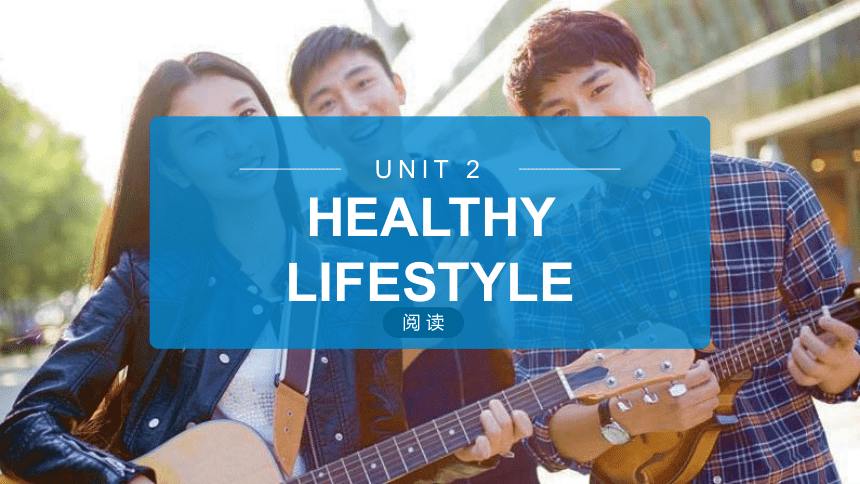 | |
| 格式 | zip | ||
| 文件大小 | 16.3MB | ||
| 资源类型 | 教案 | ||
| 版本资源 | 人教版(2019) | ||
| 科目 | 英语 | ||
| 更新时间 | 2023-02-22 14:49:02 | ||
图片预览

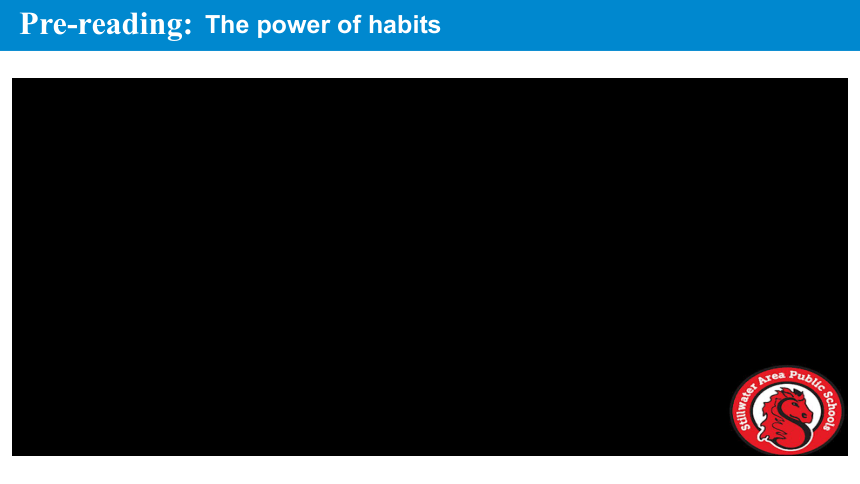

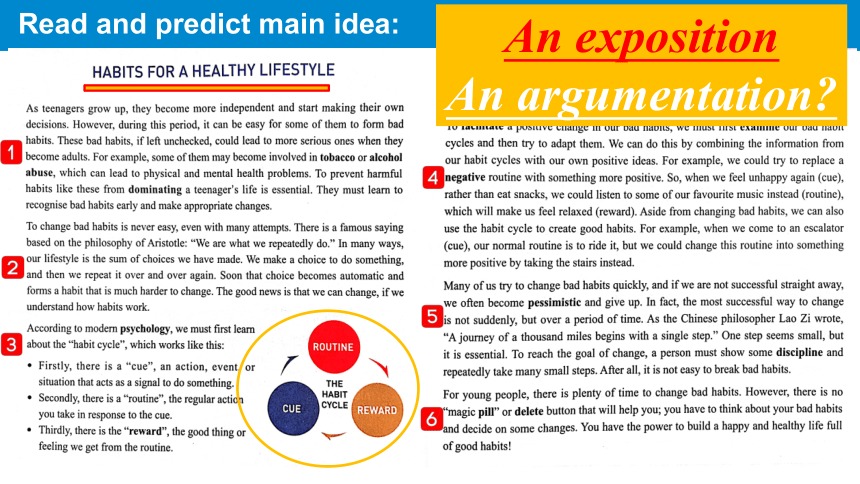
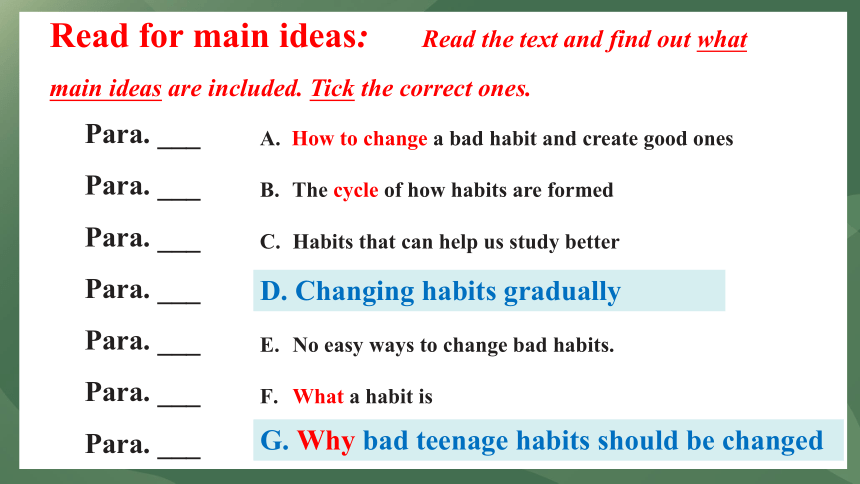
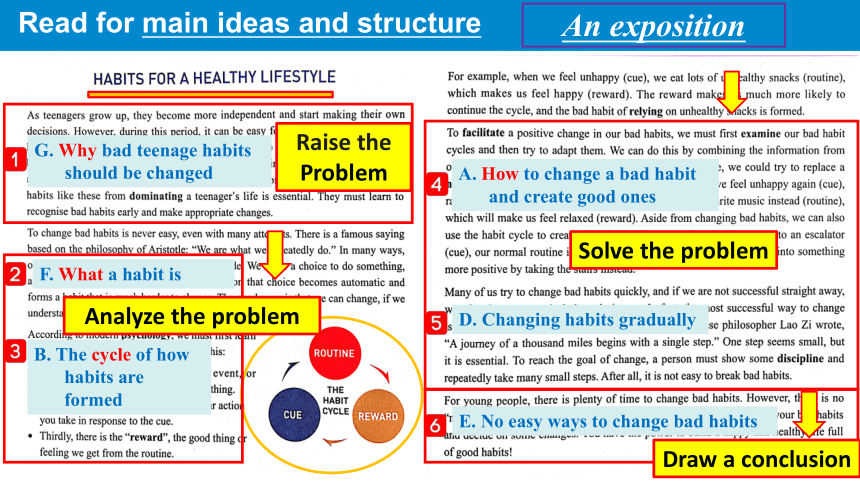
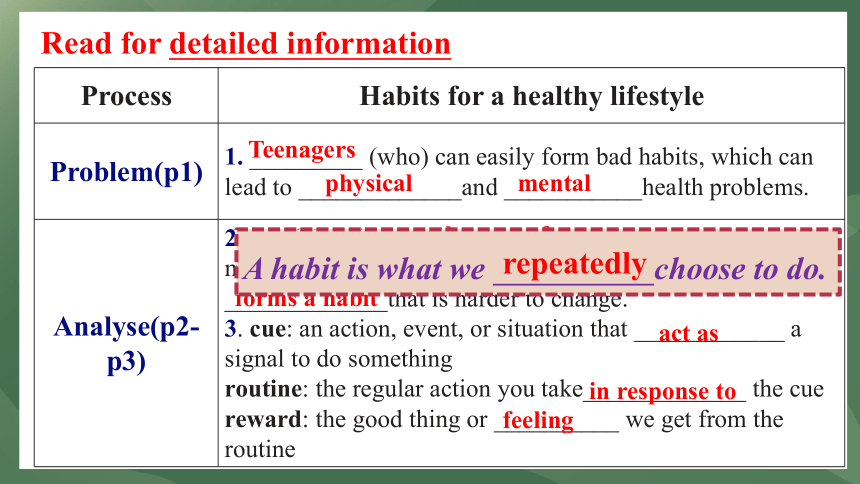
文档简介
(共17张PPT)
HEALTHY LIFESTYLE
unit 2
阅读
The power of habits
Pre-reading:
eating junk food
rarely doing exercises
staying up too late
eating too fast/overeating
not brushing the teeth
reading in bed
absorbed in computer games
Do you have any unhealthy and bad habits What are they
Bad habits are hard to change because we are usually doing things we really like and doing it too much.
smoking
Are bad habits easy to change
Why or why not
What can you do to correct
these bad habits
Pre-reading:
Read and predict main idea:
An exposition
An argumentation
An exposition
An argumentation
Read for main ideas: Read the text and find out what main ideas are included. Tick the correct ones.
A. How to change a bad habit and create good ones
The cycle of how habits are formed
Habits that can help us study better
People must repeatedly take many small steps.
No easy ways to change bad habits.
What a habit is
It’s easy for some teenagers to form bad habits.
Para. ___
Para. ___
Para. ___
Para. ___
Para. ___
Para. ___
Para. ___
D. Changing habits gradually
G. Why bad teenage habits should be changed
Read for main ideas and structure
An exposition
G. Why bad teenage habits should be changed
F. What a habit is
B. The cycle of how habits are formed
A. How to change a bad habit and create good ones
D. Changing habits gradually
E. No easy ways to change bad habits
Raise the Problem
Solve the problem
Analyze the problem
Draw a conclusion
Read for detailed information
Process Habits for a healthy lifestyle
Problem(p1) 1. _________ (who) can easily form bad habits, which can lead to _____________and ___________health problems.
Analyse(p2-p3) 2. Our lifestyle is _________________choices we have made. Soon that becomes __________ and _____________that is harder to change.
3. cue: an action, event, or situation that ____________ a signal to do something
routine: the regular action you take_____________ the cue
reward: the good thing or __________ we get from the routine
Teenagers
physical
mental
the sum of
automatic
forms a habit
act as
in response to
feeling
A habit is what we choose to do.
repeatedly
Process Habits for a healthy lifestyle
Solution(p4-p5) 4.First, _________our bad habit cycles and then try to______them. we can do this by _________the information from our habit cycles with our own
_______________.
5. A person must show some___________and repeatedly take many____________.
Conclusion(p6) 6. You have the power to build a happy and healthy life full of good habits.
examine
adapt
combining
positive ideas
discipline
small steps
Read for detailed information
Read for language features (Para1)
Scanning
Q1:Why is it essential for teenagers to prevent harmful habits
Q2:How does the author support his idea
① As teenagers grow up, they become more independent and start making their own decisions. However, during this period, it can be easy for some of them to form bad habits. These bad habits, if left unchecked, could lead to more serious ones when they become adults. For example, some of them may become involved in tobacco or alcohol abuse, which can lead to physical and mental health problems. To prevent harmful habits like these from dominating a teenager’s life is essential. They must learn to recognise bad habits early and make appropriate changes.
cause
effect
Read for language features (Para2)
Scanning
Q1:What characteristics does a habit have
Q2: How does the author support his idea
②To change bad habits is never easy, even with many attempts. There is a famous saying based on the philosopher Aristotle, “We are what we repeatedly do.” In many ways, our lifestyle is the sum of life choices we have made. We make a choice to do something, and then we repeat it over and over again. Soon that choice becomes automatic and forms a habit that is much harder to change. The good news is that we can change, if we understand how habits work.
quotation
automatic
repetitive
harder to change
Read for language features (Para3)
Scanning
Q1:What is the “habit cycle”
Q2:How does the author explain his opinion
THE
HABIRT
CYCLE
③ According to modern psychology, we must first learn about the “habit cycle”, which works like this: Firstly, there is a “cue”, an action, event, or situation that acts as a signal to do something. Secondly, there is a “routine”, the regular action you take in response to the cue. Thirdly, there is the “reward”, the good thing or feeling we get from the routine.
order of event
THE
HABIRT
CYCLE
Read for language features (Para3)
Practice
For example, when we feel unhappy, we eat lots of unhealthy snacks, which makes us feel happy. The reward makes us much more likely to continue the cycle, and the bad habit of relying on unhealthy snacks is formed.
Q1:The author gives an __________ to further explain his opinion.
example
Read for language features (Para4)
Scanning
Q1:What can you do to examine your bad habits
Q2: How does the author support his idea
④ To facilitate a positive change in our bad habits, we must first examine our bad habit cycles and then try to adapt them. We can do this by combining the information from our habit cycles with our own positive ideas. For example, we could try to replace a negative routine with something more positive. So, when we feel unhappy again (cue), rather than eat snacks, we could listen to some of our favorite music instead (routine), which will make us feel relaxed (reward). Aside from changing bad habits, we can also use the habit cycle to create good habits. For example, when we come to an escalator (cue), our normal routine is to ride it, but we could change this routine into something more positive by taking the stairs instead.
example
Read for language features (Para5)
Scanning
⑤Many of us try to change bad habits quickly, and if we are not successful straight away, we often become pessimistic and give up. In fact, the most successful way to change is not suddenly, but over a period of time. As the Chinese philosopher Lao Zi wrote, “A journey of a thousand miles begins with a single step.” One step seems small, but it is essential. To reach the goal of change, a person must show some discipline and repeatedly take many small steps. After all, it is not easy to break bad habits.
Q1: How can you reach the goal of change
Q2: How does the author support his idea
quotation
Read for language features (Para6)
Scanning
⑥ For young people, there is plenty of time to change bad habits. However, there is no “magic pill” or delete button that will help you; you have to think about your bad habits and decide on some changes. You have the power to build a happy and healthy life full of good habits!
Q1: What does the “magic pill” or delete button mean
Q2: How does the author support his idea
A quick way
Metaphor暗喻
habit cycle
cue
when we
feel sad
Routine
We eat a lots of unhealthy snacks
Reward
We feel happy
habit cycle
cue
when we
feel sad
Routine
We listen to some music or talking with friends
Reward
We feel happy
Brainstorm the habit cycle
Group Discussion(5 minutes)
How to change your unhealthy habits
①Draw two habit cycles of your own.
②Prepare a short presentation and then practice with your group members
Here are some reference:
1. To introduce your habit:
To be honest/Frankly speaking(坦白说), I have formed an unhealthy habit. That is xxx.
2.To describe the habit cycle:
In my case, when I ……(cue), I do ……(rountine). Therefore, I feel ……(reward).
3. To show how to change it:
Next time when I ……(cue), I will ……(rountine). Thus, I will ……(reward).
HEALTHY LIFESTYLE
unit 2
阅读
The power of habits
Pre-reading:
eating junk food
rarely doing exercises
staying up too late
eating too fast/overeating
not brushing the teeth
reading in bed
absorbed in computer games
Do you have any unhealthy and bad habits What are they
Bad habits are hard to change because we are usually doing things we really like and doing it too much.
smoking
Are bad habits easy to change
Why or why not
What can you do to correct
these bad habits
Pre-reading:
Read and predict main idea:
An exposition
An argumentation
An exposition
An argumentation
Read for main ideas: Read the text and find out what main ideas are included. Tick the correct ones.
A. How to change a bad habit and create good ones
The cycle of how habits are formed
Habits that can help us study better
People must repeatedly take many small steps.
No easy ways to change bad habits.
What a habit is
It’s easy for some teenagers to form bad habits.
Para. ___
Para. ___
Para. ___
Para. ___
Para. ___
Para. ___
Para. ___
D. Changing habits gradually
G. Why bad teenage habits should be changed
Read for main ideas and structure
An exposition
G. Why bad teenage habits should be changed
F. What a habit is
B. The cycle of how habits are formed
A. How to change a bad habit and create good ones
D. Changing habits gradually
E. No easy ways to change bad habits
Raise the Problem
Solve the problem
Analyze the problem
Draw a conclusion
Read for detailed information
Process Habits for a healthy lifestyle
Problem(p1) 1. _________ (who) can easily form bad habits, which can lead to _____________and ___________health problems.
Analyse(p2-p3) 2. Our lifestyle is _________________choices we have made. Soon that becomes __________ and _____________that is harder to change.
3. cue: an action, event, or situation that ____________ a signal to do something
routine: the regular action you take_____________ the cue
reward: the good thing or __________ we get from the routine
Teenagers
physical
mental
the sum of
automatic
forms a habit
act as
in response to
feeling
A habit is what we choose to do.
repeatedly
Process Habits for a healthy lifestyle
Solution(p4-p5) 4.First, _________our bad habit cycles and then try to______them. we can do this by _________the information from our habit cycles with our own
_______________.
5. A person must show some___________and repeatedly take many____________.
Conclusion(p6) 6. You have the power to build a happy and healthy life full of good habits.
examine
adapt
combining
positive ideas
discipline
small steps
Read for detailed information
Read for language features (Para1)
Scanning
Q1:Why is it essential for teenagers to prevent harmful habits
Q2:How does the author support his idea
① As teenagers grow up, they become more independent and start making their own decisions. However, during this period, it can be easy for some of them to form bad habits. These bad habits, if left unchecked, could lead to more serious ones when they become adults. For example, some of them may become involved in tobacco or alcohol abuse, which can lead to physical and mental health problems. To prevent harmful habits like these from dominating a teenager’s life is essential. They must learn to recognise bad habits early and make appropriate changes.
cause
effect
Read for language features (Para2)
Scanning
Q1:What characteristics does a habit have
Q2: How does the author support his idea
②To change bad habits is never easy, even with many attempts. There is a famous saying based on the philosopher Aristotle, “We are what we repeatedly do.” In many ways, our lifestyle is the sum of life choices we have made. We make a choice to do something, and then we repeat it over and over again. Soon that choice becomes automatic and forms a habit that is much harder to change. The good news is that we can change, if we understand how habits work.
quotation
automatic
repetitive
harder to change
Read for language features (Para3)
Scanning
Q1:What is the “habit cycle”
Q2:How does the author explain his opinion
THE
HABIRT
CYCLE
③ According to modern psychology, we must first learn about the “habit cycle”, which works like this: Firstly, there is a “cue”, an action, event, or situation that acts as a signal to do something. Secondly, there is a “routine”, the regular action you take in response to the cue. Thirdly, there is the “reward”, the good thing or feeling we get from the routine.
order of event
THE
HABIRT
CYCLE
Read for language features (Para3)
Practice
For example, when we feel unhappy, we eat lots of unhealthy snacks, which makes us feel happy. The reward makes us much more likely to continue the cycle, and the bad habit of relying on unhealthy snacks is formed.
Q1:The author gives an __________ to further explain his opinion.
example
Read for language features (Para4)
Scanning
Q1:What can you do to examine your bad habits
Q2: How does the author support his idea
④ To facilitate a positive change in our bad habits, we must first examine our bad habit cycles and then try to adapt them. We can do this by combining the information from our habit cycles with our own positive ideas. For example, we could try to replace a negative routine with something more positive. So, when we feel unhappy again (cue), rather than eat snacks, we could listen to some of our favorite music instead (routine), which will make us feel relaxed (reward). Aside from changing bad habits, we can also use the habit cycle to create good habits. For example, when we come to an escalator (cue), our normal routine is to ride it, but we could change this routine into something more positive by taking the stairs instead.
example
Read for language features (Para5)
Scanning
⑤Many of us try to change bad habits quickly, and if we are not successful straight away, we often become pessimistic and give up. In fact, the most successful way to change is not suddenly, but over a period of time. As the Chinese philosopher Lao Zi wrote, “A journey of a thousand miles begins with a single step.” One step seems small, but it is essential. To reach the goal of change, a person must show some discipline and repeatedly take many small steps. After all, it is not easy to break bad habits.
Q1: How can you reach the goal of change
Q2: How does the author support his idea
quotation
Read for language features (Para6)
Scanning
⑥ For young people, there is plenty of time to change bad habits. However, there is no “magic pill” or delete button that will help you; you have to think about your bad habits and decide on some changes. You have the power to build a happy and healthy life full of good habits!
Q1: What does the “magic pill” or delete button mean
Q2: How does the author support his idea
A quick way
Metaphor暗喻
habit cycle
cue
when we
feel sad
Routine
We eat a lots of unhealthy snacks
Reward
We feel happy
habit cycle
cue
when we
feel sad
Routine
We listen to some music or talking with friends
Reward
We feel happy
Brainstorm the habit cycle
Group Discussion(5 minutes)
How to change your unhealthy habits
①Draw two habit cycles of your own.
②Prepare a short presentation and then practice with your group members
Here are some reference:
1. To introduce your habit:
To be honest/Frankly speaking(坦白说), I have formed an unhealthy habit. That is xxx.
2.To describe the habit cycle:
In my case, when I ……(cue), I do ……(rountine). Therefore, I feel ……(reward).
3. To show how to change it:
Next time when I ……(cue), I will ……(rountine). Thus, I will ……(reward).
